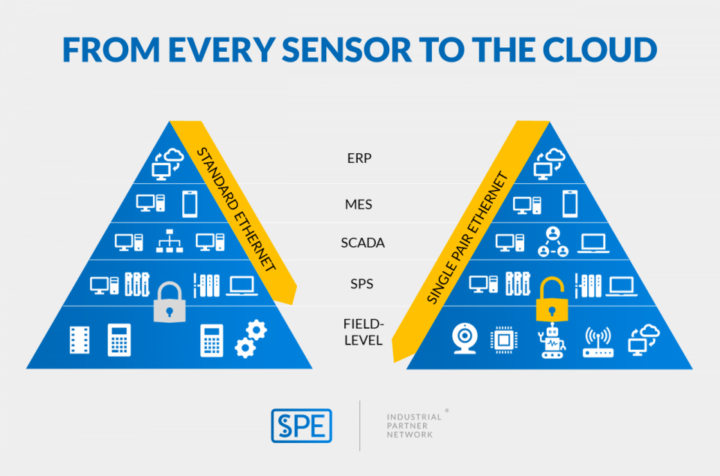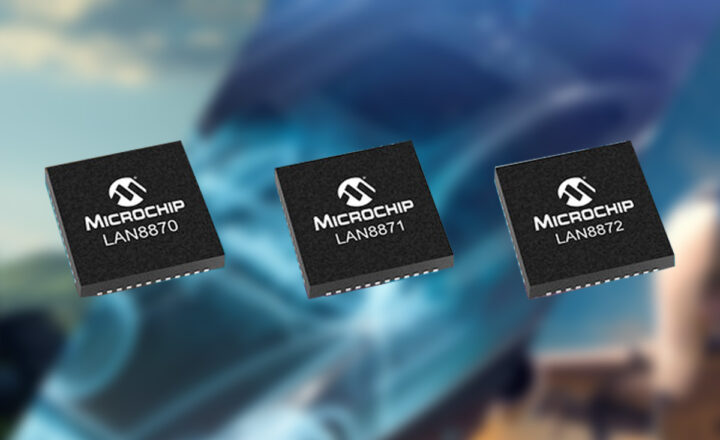Microchip has released the LAN887x family of single-pair gigabit Ethernet transceivers adding to their line of Single Pair Ethernet (SPE) devices. This new family of transceivers supports 100BASE-T1(compliant with IEEE 802bw-2015) and 1000BASE-T1(compliant with IEEE 802.3bp) network speeds and can handle extended cable lengths up to 40 meters. They also integrate time-sensitive networking (TSN) protocols and comply with ISO 26262 functional safety standards. Additionally, they can operate in low-power mode with features like EtherGREEN technology and OPEN Alliance TC10 sleep mode. All these features make this IC useful for applications such as automotive, industrial, avionics, robotics, and automation fields.
Microchip previously released the LAN8770 100BASE-T1 Ethernet PHY Transceiver which has a max cable length of 15 meters for UTP (Unshielded Twisted Pair) cable and 40 meters for STP (Shielded Twisted Pair) cable. The speed was limited to 100 Mbps, but now, with the release of the new 1000BASE-T1 ethernet controllers, the data transmission speed has been significantly increased to 1 Gbps.
Microchip’s Ethernet single-pair transceiver specifications
- Device – LAN887x family of Ethernet PHY Transceiver
- LAN8870 with RGMII and SGMII interfaces, extended cable reach for 1000BASE-T1 Type B (up to 40 meters)
- LAN8871 with RGMII interface and similar features as LAN8870, but does not support the extended cable reach for Type B (See Cable reach section for details).
- LAN8872 with SGMII interface and similar features as LAN8870, but does not support the extended cable reach for Type B.
- Supported standards
- IEEE 802.3bw-2015 (100BASE-T1)
- IEEE 802.3bp-2016 (1000BASE-T1)
- OPEN Alliance TC10 (ultra-low power sleep and wake-up)
- IEEE 802.1AS-2020 (Time-Sensitive Networking)
- IEEE 1588-2019 (Precision Time Protocol)
- MAC interfaces – RGMII and SGMII
- Cable reach
- Type A – At least 15 meters
- Type B (LAN8870B only) – At least 40 meters (potential for even longer reach)
- Power management
- FlexPWR technology for variable I/O and core power supply
- EtherGREEN energy-efficient technology
- Diagnostics
- Cable defect detection
- Receiver Signal Quality Indicator (SQI)
- Over-temperature and under-voltage protection
- status interrupt support
- Loopback and test modes
- Misc
- Microchip Functional Safety Ready
- MicroCHECK design review service available
- Time-Sensitive Networking (TSN) ready
- Temperature range
- Automotive Grade 2: -40°C to +105°C
- Industrial: -40°C to +85°C
- Package – 48-pin VQFN (7 x 7 mm) with wettable flanks
The main differences between the three ICs are the MAC interface support and 1000BASE-T1 Type B capability. The LAN8870 supports both SGMII and RGMII, whereas the LAN8871 supports only RGMII, and the LAN8872 supports only SGMII. Only LAN8870 supports 1000BASE-T1 Type B with cable reach up to 40 meters. But the LAN8871 and LAN8872 do not support this feature. you can check out the datasheet for the LAN887x family for more information.

Extending single-pair Ethernet cables to 40 meters automatically introduces signal loss and timing issues to the network. The transmitted signal tends to weaken over longer distances which causes errors, especially in noisy environments. Additionally, maintaining proper impedance to avoid signal reflections becomes more difficult, which requires careful design and potentially increasing costs. So I would take the “with cable reaches beyond the IEEE 802.3bp standard of up to at least 15 meters for type A and up to at least 40 meters for type B.” with a grain of salt.
The company mentions that the chips are designed for low power consumption so they have introduced EtherGREEN technology and EN Alliance TC10 ultra-low-power sleep mode together the standby power of this chip goes as low as 16 µA. Additionally, this chip has support for RGMII and SGMII interfaces for design flexibility and simple integration with a wide range of MCUs and SoCs.
At the time of writing the company does not provide any pricing information for the new single-pair gigabit Ethernet transceivers, but you can find a little more information on the Microchips product page or the press release.
Debashis Das is a technical content writer and embedded engineer with over five years of experience in the industry. With expertise in Embedded C, PCB Design, and SEO optimization, he effectively blends difficult technical topics with clear communication
Support CNX Software! Donate via cryptocurrencies, become a Patron on Patreon, or purchase goods on Amazon or Aliexpress





